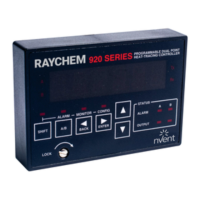30 / 82
EN- Raychem920series-IM-H5687405/15
INDUSTRIAL HEAT TRACING SOLUTIONS
user for input and/or displaying messages and status.
Setting: ENGLISH or FRANCAIS
Procedure: Select the language of choice—ENGLISH for English prompts and messages, or
FRANCAIS for French prompts and messages.
3.6.8 POINT B USED
Purpose: Allows the second control point (Point B) to be disabled when it is not being used. This is
an easy method of disabling all ALARMS, etc. without having to set each parameter.
Setting:YESorNO
Procedure:SelectNOtodisablePointB,chooseYEStousePointB.
IMPORTANT:
• SelectingNOhasthefollowingeffectonPointBparameters:
– All relevant ALARMS are masked
– The control output is held off
– No programming, configuration, or messages are available using the optional
920 Operator Console
• CompletePointBaccessremainsavailableusingtheoptionalcommunicationsinterface.
3.6.9 PASSCODE
See section 3.10.1 on page 45.
3.6.10 SCROLL DELAY SETTING (V3.11 AND UP)
Purpose: For ease of viewing, allows the user to modify the speed at which information is scrolled
on the optional Operator Console.
Range: 0.07 to 0.25 seconds
Procedure: Decreasing the scroll delay value will cause the information on the display to scroll
faster. Increasing the scroll delay value will cause the information on the display to scroll slower.
3.7 TEMPERATURE ALARMS
This section defines the temperature-related alarming functions of the 920 controller. These
parameters must be set up individually for both Point A and Point B.
3.7.1 TEMPERATURE SENSOR 1 FAILURE ALARM
Purpose: Enabling TS 1 FAILURE will provide indication of an open or shorted failure of TS 1.
Alarm Mask: ENABLE or DISABLE
Procedure: Enable or disable alarming of a failed first temperature sensor (TS 1) as required.
IMPORTANT:
• ThisfailurealarmshouldbeenabledifatemperaturesensorisconnectedtotheTS1input.
• Thisalarmisalwayslatchedandmustberesetbytheuser.
3.7.2 LOW TEMPERATURE SENSOR 1 ALARM
Purpose: If enabled, the LOW TS 1 ALARM allows for alarming of low temperature conditions as
sensed by the first temperature sensor (TS 1).
Alarm Mask: ENABLE or DISABLE
Range: –76°F to 1058°F (–60°C to 570°C)
Procedure: Adjust the LOW TS 1 ALARM temperature setpoint to the desired value. Note that the
LOW TS 1 ALARM must be enabled in order to adjust the LOW TS 1 ALARM temperature setpoint.
IMPORTANT:
• Thisalarmshouldnormallybeenabledandthesetpointshouldbeappropriatefortheheating
application. Maintaining a minimum 5°C differential between low temperature alarming and
the CONTROL SETPOINT temperature will minimize nuisance alarming due to momen-tary
dips in temperature. Another alternative to this is to configure the controller for non-latching
temperature alarms.

